|
|
|
Sort Order |
|
|
|
Items / Page
|
|
|
|
|
|
|
| Srl | Item |
| 1 |
ID:
091512
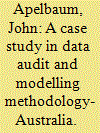

|
|
|
|
|
| Publication |
2009.
|
| Summary/Abstract |
The purpose of the paper is to outline a rigorous, spatially consistent and cost-effective transport planning tool that projects travel demand, energy and emissions for all modes associated with domestic and international transport. The planning tool (AuseTran) is a multi-modal, multi-fuel and multi-regional macroeconomic and demographic-based computational model of the Australian transport sector that overcomes some of the gaps associated with existing strategic level transport emission models. The paper also identifies a number of key data issues that need to be resolved prior to model development with particular reference to the Australian environment. The strategic model structure endogenously derives transport demand, energy and emissions by jurisdiction, vehicle type, emission type and transport service for both freight and passenger transport. Importantly, the analytical framework delineates the national transport task, energy consumed and emissions according to region, state/territory of origin and jurisdictional protocols, provides an audit mechanism for the evaluation of the methodological framework, integrates a mathematical protocol to derive time series FFC emission factors and allows for the impact of non-registered road vehicles on transport, fuel and emissions.
|
|
|
|
|
|
|
|
|
|
|
|
|
|
|
|
| 2 |
ID:
182723


|
|
|
|
|
| Summary/Abstract |
One of the most undesirable output of China's rapid economic growth has been increasing carbon emissions. This study measures and analyzes the impact of carbon emissions on China's regional total factor productivity from 2000 to 2017. Using global Malmquist-Luenberger productivity indexes, we re-estimate the provincial total factor productivity taking carbon emission into account, comparing different assumptions of returns to scale and considering the rank reverse issue. The differences of technical progress and efficiency change across Chinese regional economies are also investigated and we found that the former was the primary contributor to improved Chinese provincial productivity performance. In addition, we analyze the influencing factors of productivity based on provincial panel data. Our results indicate that innovation capacity, energy and employment structure had significant impact on the provincial productivities while urbanization had a negative impact. A more sustainable development can be expected by expanding regional investment in R&D, adjusting and optimizing structures of regional industries and energies.
|
|
|
|
|
|
|
|
|
|
|
|
|
|
|
|
| 3 |
ID:
091552


|
|
|
|
|
| Publication |
2009.
|
| Summary/Abstract |
In the context of emission markets, failure to include early action (EA) as a criterion when sharing out the reduction effort may be unfair. This paper presents (1) a method based on index decomposition that seeks to quantify EA and (2) a method for determining effort sharing considering EA. It is shown that, in the case of European industry (EU-15) and for the period 1995-2005, EA accounted for a reduction of 21% in energy-related CO2 emissions. Considering two alternative schemes for sharing out the reduction effort in European industry, equal shares (all industries in all countries reduce their emissions by the same percentage) and taking EA into account, we find that Spain, Austria, Italy, the United Kingdom and Sweden would be better off under an equal shares scheme as opposed to one that takes EA into account. The efforts of the remaining countries would be greater than if EA was taken into account. An equal shares scheme would also greatly benefit the textile, non-metallic mineral, paper and "other" industries, and would be particularly detrimental to the chemical, non-ferrous and other metal, and engineering industries.
|
|
|
|
|
|
|
|
|
|
|
|
|
|
|
|
| 4 |
ID:
169899
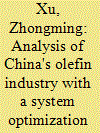

|
|
|
|
|
| Summary/Abstract |
Recently, China produces olefins increasingly from coal, although OTO (oil-to-olefins) is still dominating China's olefin industry. With the uncertain future dynamics of oil and coal prices, as well as environmental issues, how should China configure its future olefin industry? And what kind of carbon emission controlling policies should be implemented if more olefins would be produced with CTO (coal-to-olefins) in China? This paper develops a system optimization model to explore these questions. With four different scenarios of oil and coal prices, we first explore the optimal configuration of China's olefin industry without considering controlling carbon emission; then we explore the situation in which new CTO capacity must implement CCS (carbon capture and storage) for controlling carbon emission. The results of our study imply that investing in CTO technology in China is not a wrong direction, especially as a technology stock for energy safety, and it could be a good regulation to require CTO to implement CCS for achieving both economic and environmental values.
|
|
|
|
|
|
|
|
|
|
|
|
|
|
|
|
| 5 |
ID:
109759
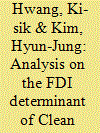

|
|
|
| 6 |
ID:
092566
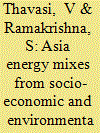

|
|
|
|
|
| Publication |
2009.
|
| Summary/Abstract |
Sustainable clean energy is the top social, economic, and environmental agenda of political leaders, policy makers, enlightened business executives, and civil society in Asia. Strong economic growth in Asia has caused a great demand for energy which has resulted in an enormous increase in CO2 emissions. The association of Southeast Asian nations (ASEAN), India, China, South Korea and Japan are the most important regions in Asia as their economies have been growing steadily. These countries though heavily dependent on fossil fuels have stepped up their measures towards low-carbon society amid domestic affordability challenges and changing global mindset. This report highlights the current energy scenario in these countries and their effort towards an affordable and sustainable clean energy future. The energy policy to enhance energy security and improve environmental sustainability is also explicated in this article.
|
|
|
|
|
|
|
|
|
|
|
|
|
|
|
|
| 7 |
ID:
091526
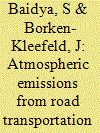

|
|
|
|
|
| Publication |
2009.
|
| Summary/Abstract |
India has become one of the biggest emitters of atmospheric pollutants from the road transportation sector globally. Here we present an up-to-date inventory of the exhaust emissions of ten species. This inventory has been calculated bottom-up from the vehicle mileage, differentiating by seven vehicle categories, four age/technology layers and three fuel types each, for the seven biggest cities as well as for the whole nation. The age composition of the rolling fleet has been carefully modelled, deducting about one quarter of vehicles still registered but actually out-of-service. The vehicle mileage is calibrated to the national fuel consumption which is essential to limit uncertainties. Sensitivity analyses reveal the primary impact of the emission factors and the secondary influence of vehicle mileage and stock composition on total emissions. Emission estimates since 1980 are reviewed and qualified. A more comprehensive inspection and maintenance is essential to limit pollutant emissions; this must properly include commercial vehicles. They are also the most important vehicle category to address when fuel consumption and CO2 emissions shall be contained.
|
|
|
|
|
|
|
|
|
|
|
|
|
|
|
|
| 8 |
ID:
136246


|
|
|
|
|
| Summary/Abstract |
The UK׳s housing stock generates approximately 27% of the country׳s total annual carbon emissions. In light of the legally binding targets to reduce carbon emissions, new housing is subject to a tightening of regulations governing energy demand and efficiency resulting in a gradual improvement in carbon emissions. The question is how to achieve the deep carbon emission reductions from existing domestic properties, of which 75% will still be in use in 2050. Government has sought to provide incentives to homeowners to improve the energy efficiency of their households, and mandate improvements in socially rented housing using a range of fiscal measures, most recently the ‘Green Deal’. There has however been little consideration of the 18% of UK households who privately rent their home, a tenure that is growing fast. The aim of this research is to investigate the factors that influence private sector landlords when considering energy efficiency improvements to their tenanted homes. The results indicate that government policy has consistently failed to engage private sector landlords in the issue of energy efficiency and thus measures must be taken to understand the motivations of landlords in order to design effective incentives and interventions.
|
|
|
|
|
|
|
|
|
|
|
|
|
|
|
|
| 9 |
ID:
132768
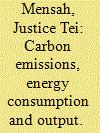

|
|
|
|
|
| Publication |
2014.
|
| Summary/Abstract |
Following the recent global economic downturn, attention has gradually shifted towards emerging economies which have experienced robust growth amidst sluggish growth of the world economy. A significant number of these emerging economies are in Africa. Rising growth in these economies is associated with surging demand for energy to propel the engines of growth, with direct implications on emissions into the atmosphere. Further, these economies are constantly being shaped by series of structural reforms with direct and indirect effects on growth, demand for energy, etc. To this end, this paper examines the causal dynamics among energy use, real GDP and CO2 emissions in the presence of regime shifts in six emerging African economies using the Gregory and Hansen (1996a). J. Econ. 70, 99-126 threshold cointegration and the Toda and Yamamoto (1995). J. Econometrics. 66, 225-250 Granger causality techniques. Results confirm the presence of regime shift effects in the long run inter-linkages among energy use, real GDP and CO2 emissions in the countries considered, thus indicating that structural changes have both economic and environmental effects. Hence, integration of energy and environmental policies into development plans is imperative towards attaining sustainable growth and development.
|
|
|
|
|
|
|
|
|
|
|
|
|
|
|
|
| 10 |
ID:
091817
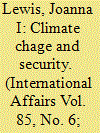

|
|
|
|
|
| Publication |
2009.
|
| Summary/Abstract |
The environment is increasingly affected by global climate change. While the causes of climate change are generated across the globe, the impacts of climate change will be highly variable at the local level. An increased scientific understanding of the potential impacts that climate change may have within China has raised new concern among China's leaders. Given that China's domestic realities inform its international policy choices, understanding how climate change may affect its population and natural resources is critical to global climate stabilization efforts. This article examines how the impacts of climate change on China, and China's response, will drive security challenges domestically, as well as in the greater Asian region and around the world. It shows that the impact of climate change on China will be significant and may have sizable adverse economic implications, particularly on vulnerable east coast economic centers. Water scarcity is a problem that already challenges China's leadership and one that will be exacerbated under projected climate impacts. In addition, the country faces the risk of international retaliation should it fail to undertake serious greenhouse gas mitigation actions. Yet China is not without options, and is already well poised to become a leader in the low-carbon technology revolution.
|
|
|
|
|
|
|
|
|
|
|
|
|
|
|
|
| 11 |
ID:
134367
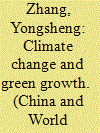

|
|
|
|
|
| Summary/Abstract |
This paper presents a new research agenda on climate change and green growth from the perspective of the division of labor in classical economics. The paper covers three major dimensions of green growth (i.e. carbon emissions, environmental protection and material resources use) and some related important topics, as well as the fresh policy implications of the new research agenda, Typical marginal analysis in a given structure of the division of labor suggests that “green” action is a burden to economic development. Therefore, climate negotiation has become a burden-sharing game and has reached a stalemate. New thinking is badly needed to rescue these negotiations and to drive a shift to a new “green growth” paradigm. The proposed new research agenda represents an effort to create a new narrative on climate change and green growth. Because the new research agenda can theoretically predict the possibility that a more competitive structure of the division of labor could be triggered by “green” policy, it has promising policy implications for various important challenges facing us in the 21st century.
|
|
|
|
|
|
|
|
|
|
|
|
|
|
|
|
| 12 |
ID:
091387
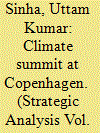

|
|
|
|
|
| Publication |
2009.
|
| Summary/Abstract |
Climate change is hugely challenging. But there is an unmistakable straighforwardness to it reduce emissions to reduce global warming. In many ways, this reflects the sum total of the paradoxes that define our reality and the contradictions and hypocricy of coping and dealing with it.
|
|
|
|
|
|
|
|
|
|
|
|
|
|
|
|
| 13 |
ID:
091529
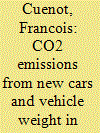

|
|
|
|
|
| Publication |
2009.
|
| Summary/Abstract |
A segment- and fuel-disaggregated analysis of the production data of the new European vehicle market during the last decade helps to understand the sharp increase in average weight, and to introduce an indicator linking CO2 emissions to a vehicle's unit of weight. Using this indicator, simulations are made to calculate the average CO2 emissions if the average weight had stayed constant from 1995 to 2005. If the weight had remained constant, the 2008 target of 1998s voluntary agreement (VA) would have been met, and the recently approved regulation would probably have been unnecessary. Then, CO2 emissions are projected to 2015 using different vehicle characteristics and market penetration. Five scenarios have been introduced to study the different opportunities that could arise by 2015, including a backcasting scenario showing what is needed to reach the goal set by the recently approved EU climate package regulations. The analysis concludes that powertrain technologies alone are unlikely to bring the sufficient break in trends to reach set targets. Acting on average weight, through unitary vehicle weight or segment shifting, of new vehicles is key in reducing the average CO2 emissions in the short and medium term.
|
|
|
|
|
|
|
|
|
|
|
|
|
|
|
|
| 14 |
ID:
124506
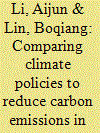

|
|
|
|
|
| Publication |
2013.
|
| Summary/Abstract |
Currently, China is the largest carbon emitter mainly due to growing consumption of fossil fuels. In 2009, the Chinese government committed itself to reducing domestic carbon emissions per unit of GDP by 40-45% by 2020 compared to 2005 levels. Therefore, it is a top priority for the Chinese government to adopt efficient policy instruments to reduce its carbon intensity. Against this background, this paper develops a general equilibrium model and seeks to provide empirical contributions by comparing the potential impacts of several different policy options to reduce China's carbon emissions. The main findings are as follows. Firstly, these climate policies would affect the structure of economy and contribute to carbon emissions reduction and carbon intensity reduction. Secondly, there would be significant differences in the economic and environmental effects among different climate policies and hence, the government would trade-off among different economic objectives to overcome any potential resistances. Thirdly, there would be considerable differences in the emissions effects of absolute and intensity-based carbon emissions controls, implying that the government might adopt different climate policies for absolute or intensity-based carbon emissions controls. Looking ahead, the government should trade-off among different objectives when designing climate reforms.
|
|
|
|
|
|
|
|
|
|
|
|
|
|
|
|
| 15 |
ID:
132607
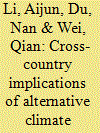

|
|
|
|
|
| Publication |
2014.
|
| Summary/Abstract |
Because of worldwide growing concerns about global climate change, great interest has been expressed in the potential of alternative climate policies to reduce global carbon emissions. In this paper, we compare cross-country implications of alternative climate policies, including unilateral and multilateral climate policies. Our main findings are as follows. Firstly, there are large differences in cross-country effects of alternative unilateral climate policies, when the same given carbon emission reductions are achieved in each abating country respectively. Meanwhile, cross-border externalities undermine efficiency of unilateral climate policies. Secondly, there are significant differences in cross-country implications of alternative multilateral climate policies, when the same global emission reductions are allocated in several different ways among abating countries. Thirdly, it is difficult to reach a stable global climate treaty, since any abating country has the incentive to argue for small carbon emission reductions. Finally, multilateral climate policies can reduce the negative impacts of cross-border externalities, but cannot cure all cross-border externalities. Looking ahead, it will be a great policy challenge for the world to reduce carbon emissions in a cost-effective way.
|
|
|
|
|
|
|
|
|
|
|
|
|
|
|
|
| 16 |
ID:
136203


|
|
|
|
|
| Summary/Abstract |
The European Union׳s current climate and energy policy has to operate under an ex ante unforeseen economic crisis. As a consequence prices for carbon emission allowances in the EU Emissions Trading System collapsed. However, this price collapse may be amplified by the interaction of a carbon emission cap with supplementary policy targets such as minimum shares for renewables in the power sector. The static interaction between climate and renewable policies has been discussed extensively. This paper extends this debate by analysing the efficiency and effectiveness of a policy portfolio containing a cap and trade scheme and a target for a minimum renewable share in different states of aggregate electricity demand. Making use of a simple partial equilibrium model of the power sector we identify an asymmetric interaction of emissions trading and renewable quotas with respect to different states of aggregate electricity demand. The results imply that unintended consequences of the policy interaction may be particularly severe and costly when aggregate electricity demand is low and that carbon prices are more sensitive to changes in economic activity if they are applied in combination with renewable energy targets. Our analysis of the policy interaction focuses on the EU, yet the conclusions may also be of relevance for fast growing emerging economies like China.
|
|
|
|
|
|
|
|
|
|
|
|
|
|
|
|
| 17 |
ID:
091697
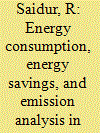

|
|
|
|
|
| Publication |
2009.
|
| Summary/Abstract |
This paper is concerned with the estimation of energy use in office buildings in Malaysia and with the energy use of major equipment. Energy intensity (EI) - a measure of a building's energy performance - is estimated for Malaysia and compared with a number of selected countries. Air conditioners are shown to be the major energy users (57%) in office buildings, followed by lighting (19%), lifts and pumps (18%) and other equipment (6%). It is estimated that 77,569 MWh of energy can be saved and a huge reduction of emissions achieved through the application of advance glazing, compact fluorescent lamps (CFL), insulation, housekeeping, and by raising thermostat set point temperature of air conditioners, and reducing EI.
|
|
|
|
|
|
|
|
|
|
|
|
|
|
|
|
| 18 |
ID:
128046


|
|
|
|
|
| Publication |
2014.
|
| Summary/Abstract |
Transportation contributes to resource depletion and has other negative impacts on the environment. The present study presents models of energy demand and environmental emissions for the land transportation sector in Metro Manila, Philippines from 2010 to 2040 using the "Long Range Energy Alternatives Planning (LEAP)" tool. The study projected energy demand and CO2, CO, HC, NOx and PM10 emissions for Business-As-Usual (BAU) and alternative scenarios and compared the results while aiming to determine optimal transportation policies to reduce energy demand and emissions. The results indicated that the adoption of EURO 4 emission standards provides the greatest reduction in energy use at 10.8%, while the best cases for the various gas emissions were split among different options. In addition, a combination of all of the alternatives is expected to lower energy use by 27.8% and to reduce CO2, CO, HC, NOx and PM10 by 30.3%, 60.3%, 59.0%, 48.2% and 66.4%, respectively. The analytical framework employed herein could be applied to other cities to evaluate and prioritize strategies to reduce future energy requirements and emissions.
|
|
|
|
|
|
|
|
|
|
|
|
|
|
|
|
| 19 |
ID:
091516


|
|
|
|
|
| Publication |
2009.
|
| Summary/Abstract |
This paper describes the energy consumption performance of sea-going ships engaged in the EU27 seaborne trades based on data and parameters resulting from the EX-TREMIS (EXploring non road TRansport EMISsions in Europe) database. EX-TREMIS is a comprehensive database of fleet and transport activity data, specific energy consumption, emission factors and total emissions from rail, maritime and air transport in the European Union. The EX-TREMIS maritime model derives from a mixture of top-down and bottom-up approaches for estimating pollutant emissions from shipping activities. The model did not use direct observations of actual trips, but empirically derived the number of equivalent-ships. Cargo type shipments were linked to seven ship type categories for which a further segmentation by ship size (three length classes), type and age of the main engine and type of fuel was applied.
|
|
|
|
|
|
|
|
|
|
|
|
|
|
|
|
| 20 |
ID:
091533
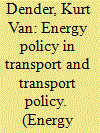

|
|
|
|
|
| Publication |
2009.
|
| Summary/Abstract |
Explanations for, and indirect evidence of, imperfections in the market for private passenger vehicle fuel economy suggest there is a reasonable case for combining fuel economy standards and fuel or carbon taxes to contribute to an energy policy that aims to reduce greenhouse gas emissions and improve energy security. Estimates of key elasticities, including the rebound effect, indicate that the positive and negative side-effects of fuel economy measures on transport activities and external costs are limited. However, an energy policy for transport does not replace a transport policy that aims to manage the main transport externalities including congestion and local pollution. Conventional marginal cost estimates and standard cost-benefit reasoning suggest that policies that address congestion and local pollution likely bring benefits at least as large as those from fuel economy measures. But the large uncertainty on the possible effects of greenhouse gas emissions constitutes a strong challenge for standard cost-benefit reasoning. Emerging results from methods to cope with this uncertainty suggest that policies to stimulate the widespread adoption of low-carbon technologies in transport are justified.
|
|
|
|
|
|
|
|
|
|
|
|
|
|
|
|
|
|
|
|
|